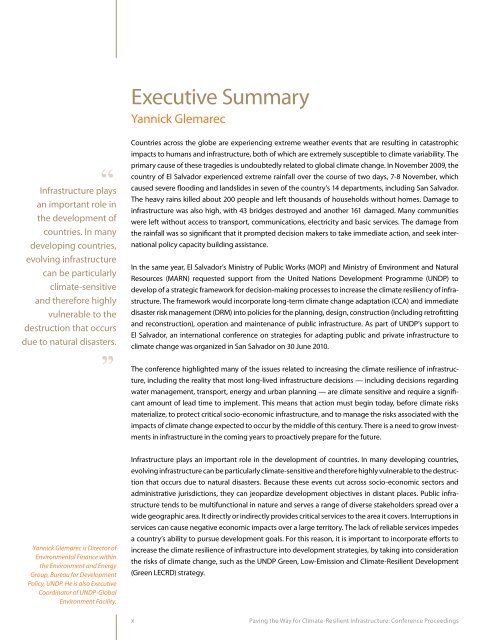Paving the Way for Climate-Resilient Infrastructure - UN CC:Learn
Paving the Way for Climate-Resilient Infrastructure - UN CC:Learn
Paving the Way for Climate-Resilient Infrastructure - UN CC:Learn
Create successful ePaper yourself
Turn your PDF publications into a flip-book with our unique Google optimized e-Paper software.
Executive SummaryYannick Glemarec‘‘<strong>Infrastructure</strong> playsan important role in<strong>the</strong> development ofcountries. In manydeveloping countries,evolving infrastructurecan be particularlyclimate-sensitiveand <strong>the</strong>re<strong>for</strong>e highlyvulnerable to <strong>the</strong>destruction that occursdue to natural disasters.’’Countries across <strong>the</strong> globe are experiencing extreme wea<strong>the</strong>r events that are resulting in catastrophicimpacts to humans and infrastructure, both of which are extremely susceptible to climate variability. Theprimary cause of <strong>the</strong>se tragedies is undoubtedly related to global climate change. In November 2009, <strong>the</strong>country of El Salvador experienced extreme rainfall over <strong>the</strong> course of two days, 7-8 November, whichcaused severe flooding and landslides in seven of <strong>the</strong> country’s 14 departments, including San Salvador.The heavy rains killed about 200 people and left thousands of households without homes. Damage toinfrastructure was also high, with 43 bridges destroyed and ano<strong>the</strong>r 161 damaged. Many communitieswere left without access to transport, communications, electricity and basic services. The damage from<strong>the</strong> rainfall was so significant that it prompted decision makers to take immediate action, and seek internationalpolicy capacity building assistance.In <strong>the</strong> same year, El Salvador’s Ministry of Public Works (MOP) and Ministry of Environment and NaturalResources (MARN) requested support from <strong>the</strong> United Nations Development Programme (<strong>UN</strong>DP) todevelop of a strategic framework <strong>for</strong> decision-making processes to increase <strong>the</strong> climate resiliency of infrastructure.The framework would incorporate long-term climate change adaptation (<strong>CC</strong>A) and immediatedisaster risk management (DRM) into policies <strong>for</strong> <strong>the</strong> planning, design, construction (including retrofittingand reconstruction), operation and maintenance of public infrastructure. As part of <strong>UN</strong>DP’s support toEl Salvador, an international conference on strategies <strong>for</strong> adapting public and private infrastructure toclimate change was organized in San Salvador on 30 June 2010.The conference highlighted many of <strong>the</strong> issues related to increasing <strong>the</strong> climate resilience of infrastructure,including <strong>the</strong> reality that most long-lived infrastructure decisions — including decisions regardingwater management, transport, energy and urban planning — are climate sensitive and require a significantamount of lead time to implement. This means that action must begin today, be<strong>for</strong>e climate risksmaterialize, to protect critical socio-economic infrastructure, and to manage <strong>the</strong> risks associated with <strong>the</strong>impacts of climate change expected to occur by <strong>the</strong> middle of this century. There is a need to grow investmentsin infrastructure in <strong>the</strong> coming years to proactively prepare <strong>for</strong> <strong>the</strong> future.Yannick Glemarec is Director ofEnvironmental Finance within<strong>the</strong> Environment and EnergyGroup, Bureau <strong>for</strong> DevelopmentPolicy, <strong>UN</strong>DP. He is also ExecutiveCoordinator of <strong>UN</strong>DP-GlobalEnvironment Facility.<strong>Infrastructure</strong> plays an important role in <strong>the</strong> development of countries. In many developing countries,evolving infrastructure can be particularly climate-sensitive and <strong>the</strong>re<strong>for</strong>e highly vulnerable to <strong>the</strong> destructionthat occurs due to natural disasters. Because <strong>the</strong>se events cut across socio-economic sectors andadministrative jurisdictions, <strong>the</strong>y can jeopardize development objectives in distant places. Public infrastructuretends to be multifunctional in nature and serves a range of diverse stakeholders spread over awide geographic area. It directly or indirectly provides critical services to <strong>the</strong> area it covers. Interruptions inservices can cause negative economic impacts over a large territory. The lack of reliable services impedesa country’s ability to pursue development goals. For this reason, it is important to incorporate ef<strong>for</strong>ts toincrease <strong>the</strong> climate resilience of infrastructure into development strategies, by taking into consideration<strong>the</strong> risks of climate change, such as <strong>the</strong> <strong>UN</strong>DP Green, Low-Emission and <strong>Climate</strong>-<strong>Resilient</strong> Development(Green LECRD) strategy.x<strong>Paving</strong> <strong>the</strong> <strong>Way</strong> <strong>for</strong> <strong>Climate</strong>-<strong>Resilient</strong> <strong>Infrastructure</strong>: Conference Proceedings
















